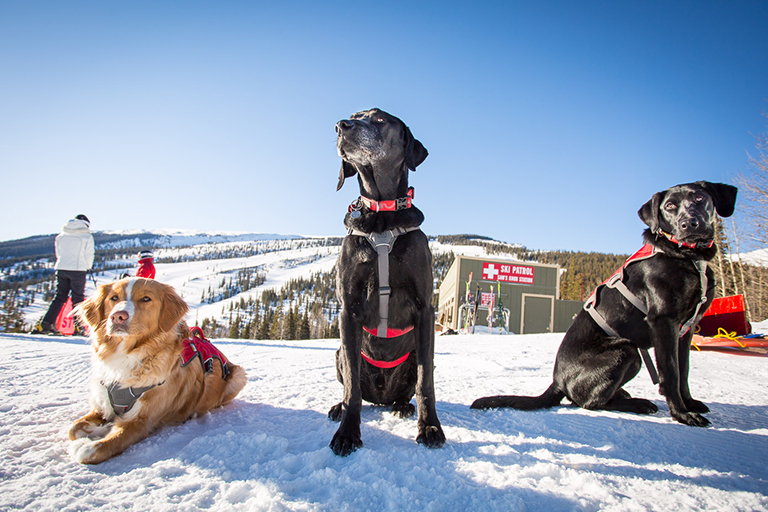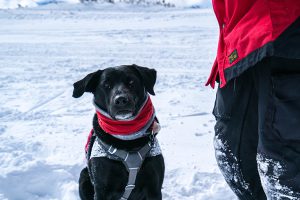By Amy Higgins –

Snowmass’ Piper (pictured with handler Dan Berg) is more than just a pretty face. Photo courtesy of Vital Films.
Regal, resilient and, just plain cute, the dogs working Colorado’s ski slopes are impossible to ignore. They play an important role for each resort’s public relations endeavors, and many Colorado avalanche dogs have an even bigger purpose, for the ski facility as well as the communities surrounding them.
A DOG’S WORK IS NEVER DONE
“Are you ready to work?” “Search!” These are the typical commands an avalanche dog responds to on a rescue or recovery mission. They aren’t necessarily commands that are set in stone industrywide, but they are quite routine amongst Colorado avalanche dogs and their handlers as a way to be consistent with one another.
“They know when people are under the snow in case of an avalanche,” says Dan Berg, Snowmass avalanche dog coordinator, whose team of avalanche dogs, or “avy” dogs, consists of Piper, Odin, Mabel and Hatchet. “As ski patrollers, we do avalanche control so that people are safe on the hill. In the unlikely case that we do have an avalanche, we have them there to help us dig that person out.”
The skill of these avalanche teams is not only utilized at the ski areas where they are employed, but also with organizations such as the local sheriffs’ offices, search-and-rescue teams and Flight for Life.
THE MAKINGS OF A COLORADO AVALANCHE DOG
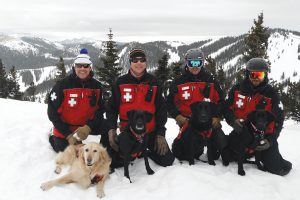
The Monarch ski patrol team. Photo courtesy of Monarch Ski Patrol.
Clearly, not just any dog can become an avy dog — it takes good genes, a strong hunting instinct, a trained handler, challenging drills and much more. “They’re identified and chosen when they’re still in the litter,” says John Reller, dog coordinator at Colorado Rapid Avalanche Deployment, or C-RAD. Sporting and working dogs, such as retrievers, Labradors, Australian shepherds and border collies, make good avalanche rescue dog candidates, he says. In addition, there is a puppy aptitude test that helps predict how the dog will train, search and work.
“If a dog can exhibit a very strong drive and good motivation, then it’s a good candidate for the program,” says Rick LaRocca, a ski patroller at Winter Park and handler of Nuggit, a C-RAD certified avalanche dog. “Once you start working the dog, you get a good idea of the individual personality traits and what hurdles you might have to jump with that animal, or if it’s even possible to put the dog through the program.”
Training starts right away for puppies with such activities as “runaways.” One person holds the pup while the handler runs away with a toy in hand. The puppy is released and runs to find the handler to fetch the toy. There’s a lot of repetitiveness, high-pitched praise and celebration to keep the dog engaged.
“Sometimes it’s harder to train the people because we can be, without knowing, very inconsistent and the dogs pick up on all those things,” Reller says. “A lot of people that train with me know that I call myself the dumb end of the leash. The dog is the smart end of the leash.”
Several Colorado ski areas utilize the training and resources provided by C-RAD, which started pooling the expertise of search-and-rescue teams, Flight for Life, sheriffs’ departments and ski patrols in 1991 to create the avalanche deployment program. And the teams in the C-RAD program are continually honing their skills.
TEAMWORK MAKES THE DREAM WORK
It takes three heartbeats, as LaRocca describes it, to make a team: the avalanche dog, the dog’s handler and an avalanche technician. The avalanche technician is trained to identify areas that are at risk for an avalanche, perform controlled avalanches and assess the scene of an avalanche to determine whether it is safe for an avalanche rescue, recovery mission or public access. When the area is cleared, the avy dog and handler use their training and camaraderie to locate the avalanche victims.
C-RAD, based in Summit County, puts the dogs and their handlers to the test through simulated avalanche drills, which includes a helicopter, snowmobile or car ride — routines the avy dogs become accustomed to. Each team is required to clear a 300-foot by 300-foot area in a maximum time of 20 minutes. Within that area are an unknown number of potential “victims” — handlers pretending to be buried in an avalanche — hidden beneath the snow in caves at varying depths, the entrances blocked with more snow.
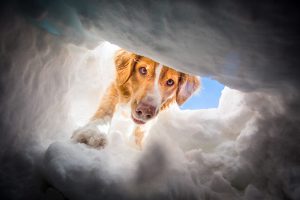
Snowmass’ Piper digs to find the “victim” during a simulated avalanche drill. Photo courtesy of Vital Films.
“I’ve personally been buried 6 feet and I was found by one of our dogs,” says Rich Rogers, lead avalanche dog handler at Monarch Mountain. The snow caves are dug beforehand, leaving plenty of room for the victim impersonator to lie down comfortably. “The first time it was a little unnerving. If you’re claustrophobic, that’s not the activity for you,” he says with a laugh.
The dogs use their heightened sense of smell and hearing as well as verbal cues and body language from their handlers to locate the victim. When a victim is detected, the dogs indicate their find by digging aggressively. The dogs continue the search until the area is cleared. The teams are graded on how the dog works, how the handler works and how they work as a team.
Once a victim is found, the handler and dog play a game of tug-of-war to celebrate a job well done. The dog always wins. “That’s all they want to do,” LaRocca says. Trainers and handlers carry a specific tug toy that’s not only used to play with the dogs, but also to pull a victim out of the snow.
“This all goes back to the primeval hunt drive that they have,” LaRocca explains. “The tug is actually simulating the tearing of meat from the bone. It’s all kind of caveman stuff.” The handler uses a lot of animation and high-voice praise to let the dog know he did a good job finding the victim. “You might think that sounds strange at first, but it’s proven that they respond the best to crazy animated behavior and super high voices,” he says. “But it gets the dog’s hunt drive going and really is super effective.”
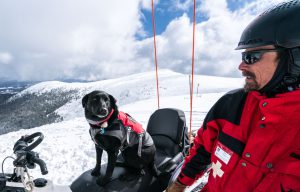
Winter Park’s Nuggit gets ready for a rescue simulation. Photo courtesy of Carl Frey/Winter Park Resort.
Simulated avalanche drills are held often, once or twice a month for Monarch Mountain avy dog Anchin. “With workload, that gets [time] determined,” explains Rogers, Anchin’s handler. “We’re not setting up scenarios when we’re super busy, but any time in between we’re trying to set something up and keep him on his toes; keep him ready.”
“The number one goal of an avalanche dog, of course, is a live find: finding a live victim,” LaRocca says. “But the other great goal of a good working dog is to have them search for a half an hour, 40 minutes or longer with no find, but still reward them afterward to let them know they did a great job, just so they don’t get bored or depressed or distracted.”
HURDLES AND HIGH POINTS FOR COLORADO AVALANCHE DOGS
An avy dog’s life is full of excitement, activity, praise and affection, but it’s hard work and comes with its fair share of hardships. “It is hard on these animals,” LaRocca says. “They don’t get their daily nap that a normal dog would get, which shortens their lives.”
Just like any dog, avy dogs sense emotion. Reller tells the story of the search for a snowmobiler who, unfortunately, had to be recovered rather than rescued. Understandably, the victim’s wife began to sob at the scene. Initially, Reller’s focus was on the grieving widow. Then he heard a strange noise. “It was my dog making a wailing sound, but it was the same pitch as the lady. She was imitating her,” he explains. “She quickly reminded me that she was upset as well.
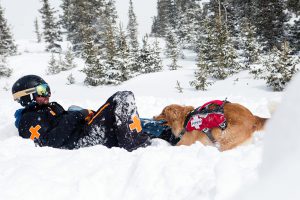
It’s important to reward an avy dog with games like tug-of-war after she does her job. Pictured are Piper and her handler Dan Berg at Snowmass. Photo courtesy of Vital Films.
“She had done everything I asked her to do,” Reller says. “I had to take her off to the side and go reward her so it stayed a fun game and she would continue to do it again in the future for me.”
Colorado avalanche dogs have a full workload at the ski resort, just like their handlers. Although the dogs spend more time in the patrol shacks during busy times, such as big snow days, holidays and days when injuries are prevalent, avy dogs spend much of their time sharpening their capabilities. “Every day I’m up there, we’re working together from the start of the day to the end of the day. It’s a full eight- or nine-hour workday for them,” Rogers says.
It can be dangerous on the hill for avy dogs when a lot of people are around. Things like snowboard edges, ski poles and heavy traffic could injure the dog, so handlers take precautions in regard to these dangers on the mountain.
While an avalanche rescue is the most rewarding, recovery missions are vital and beneficial for all involved. “Almost all the time what we’re capable of doing is bringing closure to the situation, which helps friends, family, the town,” Reller explains. “To me, as a handler, to see them do exactly what we trained them to do is incredibly rewarding. Even in those situations, the closure that it brings to everybody else of having their loved one, that unknown [location] of them being out there, out there in the snow somewhere, it brings closure to that situation.”
The emotional and physical toll that is placed on avalanche dogs — and, in fact, their handlers — can affect their overall well-being, so keeping spirits high in stressful situations is essential. “It’s a challenge for us to do things correctly and reward the dogs appropriately,” Reller says. “Keep in mind that they are part of the team. We test as a team, so we have to take care of each other as a team, too.”
In the end, for Colorado’s avalanche dog handlers, the fulfillment of the job outshines the difficulties by far. “It’s more rewarding than anything I’ve done in my life,” LaRocca says. “It is 100 percent the best to be dragged by my dog to go to work.”
Amy Higgins is a freelance writer who doesn’t mind a little slobber on the cheek if it means getting a little time with a friendly dog.
Want an opportunity to coddle canines at Colorado’s ski resorts? Read Simply Irresistible: Colorado Snow Dogs.

